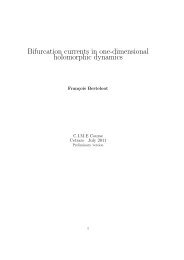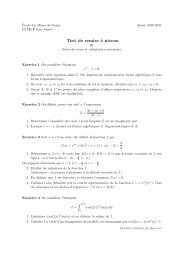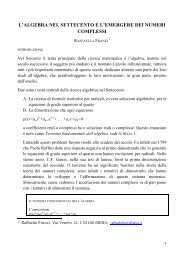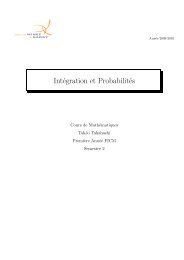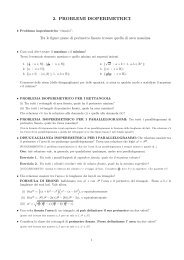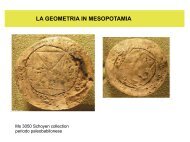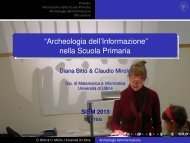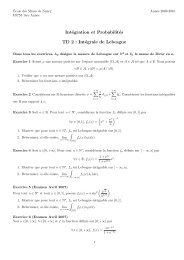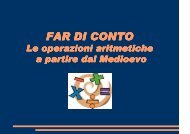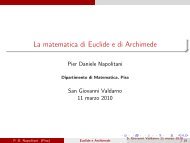Derivation of a fundamental diagram for urban traffic flow
Derivation of a fundamental diagram for urban traffic flow
Derivation of a fundamental diagram for urban traffic flow
Create successful ePaper yourself
Turn your PDF publications into a flip-book with our unique Google optimized e-Paper software.
D. Helbing: <strong>Derivation</strong> <strong>of</strong> a <strong>fundamental</strong> <strong>diagram</strong> <strong>for</strong> <strong>urban</strong> <strong>traffic</strong> <strong>flow</strong> 11<br />
area. Considering the heterogeneity <strong>of</strong> the link lengths L i ,<br />
efficiencies ɛ i , utilizations u i , and densities ρ av<br />
i , one could<br />
think that the spread in the data would be enormous.<br />
However, a considerable amount <strong>of</strong> smoothing results from<br />
the fact that in- and out<strong>flow</strong>s <strong>of</strong> links within the studied<br />
<strong>urban</strong> area cancel out each other, and it does not matter<br />
whether a vehicle is delayed in a particular link, or<br />
in the previous or subsequent one. There<strong>for</strong>e, the resulting<br />
<strong>fundamental</strong> <strong>diagram</strong>s <strong>for</strong> <strong>urban</strong> areas are surprisingly<br />
smooth [29,30]. The details <strong>of</strong> the curves, however, are expected<br />
to depend not only on the average density, but also<br />
on the density distribution, the signal operation schemes,<br />
and potentially other factors as well.<br />
When averaging over different links, we have to study<br />
the effects <strong>of</strong> the averaging procedure on the density and<br />
the speed. The density just averages linearly: thanks to<br />
Little’s law [39], the <strong>for</strong>mula (76) can also be applied to<br />
an <strong>urban</strong> area, as long as the average number <strong>of</strong> vehicles<br />
in it is stationary. However, as the link-based <strong>fundamental</strong><br />
<strong>diagram</strong> between the <strong>flow</strong> Q(ρ) =ρV av (ρ) andthedensity<br />
ρ is convex, evaluating the <strong>flow</strong> at some average density<br />
overestimates the average <strong>flow</strong> 2 . This also implies that,<br />
when the relationship V av (ρ) is transferred from single<br />
links to <strong>urban</strong> areas, the average speed is overestimated<br />
<strong>for</strong> a given density, as reference [31] hasshown.<br />
Despite this expected deviation in heterogeneous and<br />
inhomogeneously used road networks, and despite the<br />
many other simplifications, the curve V av (ρ) fitsempirical<br />
data <strong>of</strong> the speed-density relation in an <strong>urban</strong> area<br />
quite well. Figure 6 displays empirical data obtained <strong>for</strong><br />
the center <strong>of</strong> Yokohama [29] together with a fit <strong>of</strong> the theoretical<br />
speed-density relationship V av (ρ), where only the<br />
three parameters V 0 , δ, andV ∗ = L/T los were adjusted.<br />
Surprisingly, the effects <strong>of</strong> network interactions could be<br />
sufficiently well represented by a single parameter δ,which<br />
relates to the efficiency ɛ <strong>of</strong> road sections according to<br />
equation (32). This approximation seems to work in situations<br />
close enough to a statistical equilibrium (when the<br />
number <strong>of</strong> vehicles in the <strong>urban</strong> area does not change too<br />
quickly).<br />
In contrast, <strong>for</strong> an understanding <strong>of</strong> the spreading dynamics<br />
<strong>of</strong> congestion patterns, we expect that one must<br />
study the interaction between the <strong>flow</strong> dynamics and the<br />
network structure. This difficult subject goes beyond the<br />
scope <strong>of</strong> this paper and beyond what is doable at the moment,<br />
but it will be interesting to address it in the future.<br />
2 When averaging over speed values, they have to be<br />
weighted by the number <strong>of</strong> vehicles concerned, i.e. by the density.<br />
This comes down to determining an arithmetic average<br />
<strong>of</strong> the <strong>flow</strong> values and dividing the result by the arithmetic<br />
average <strong>of</strong> the related densities. Hence, an overestimation <strong>of</strong><br />
the average <strong>flow</strong> also implies an overestimation <strong>of</strong> the average<br />
velocity. However, considering the curvature <strong>of</strong> Q(ρ) and<br />
knowing the variability <strong>of</strong> the density ρ allows one to estimate<br />
correction terms.<br />
3 This corresponds to 10% extra green time, an average distance<br />
between successive <strong>traffic</strong> lights <strong>of</strong> roughly 100 m (depending<br />
on T los ), and an average <strong>of</strong> 3 <strong>traffic</strong> phases (which appears<br />
plausible, considering that there are many one-way roads,<br />
Speed (km/h)<br />
35<br />
30<br />
25<br />
20<br />
15<br />
10<br />
5<br />
0<br />
0 0.02 0.04 0.06 0.08 0.1<br />
Density (1/m)<br />
Fig. 6. (Color online) Fundamental velocity-density relationship<br />
<strong>for</strong> a central area <strong>of</strong> Yokohama. Small circles correspond<br />
to empirical data by Kuwahara as evaluated by Daganzo<br />
and Geroliminis [31]. The fit curve corresponds to the theoretically<br />
derived equations (74) to(76), where the out<strong>flow</strong><br />
(discharge <strong>flow</strong>) ̂Q = 1800 veh./h/lane and the free speed<br />
V 0 = 50 km/h have been fixed. The only fit parameters were<br />
δ =0.1, T los /T 0 =1.4, and s =3 3 .<br />
The author thanks <strong>for</strong> an inspiring presentation by Carlos<br />
Daganzo, <strong>for</strong> useful comments by Stefan Lämmer, and intresting<br />
discussions with Nikolas Geroliminis, who was also kind<br />
enough to provide the empirical data from the center <strong>of</strong> Yokohama<br />
displayed in Figure 6, see Figure 7 in reference [29].<br />
He extracted these from original data <strong>of</strong> GPS-equipped taxis<br />
by Pr<strong>of</strong>. Masao Kuwahara from the University <strong>of</strong> Tokyo. The<br />
fit <strong>of</strong> the theoretically predicted relationship to the empirical<br />
data was carried out by Anders Johansson. Furthermore,<br />
the author is grateful <strong>for</strong> partial support by the Daimler-<br />
Benz Foundation Project 25-01.1/07 on BioLogistics, the VW<br />
Foundation Project I/82 697, the NAP project KCKHA005<br />
“Complex Self-Organizing Networks <strong>of</strong> Interacting Machines:<br />
Principles <strong>of</strong> Design, Control, and Functional Optimization”,<br />
and the ETH Competence Center ‘Coping with Crises in Complex<br />
Socio-Economic Systems’ (CCSS) through ETH Research<br />
Grant CH1-01-08-2.<br />
Appendix A: Determination <strong>of</strong> average travel<br />
times and velocities<br />
Let f(x) be a function and w(x) a weight function. Then,<br />
the average <strong>of</strong> the function between x = x 0 and x = x 1 is<br />
which need less than 4 phases in one cycle time). Consequently,<br />
all parameters are quite reasonable (see also Ref. [31]). Note<br />
that effects <strong>of</strong> oversaturation did not have to be considered in<br />
Figure 6. This is, in fact, consistent with pictures from Google<br />
Earth.



